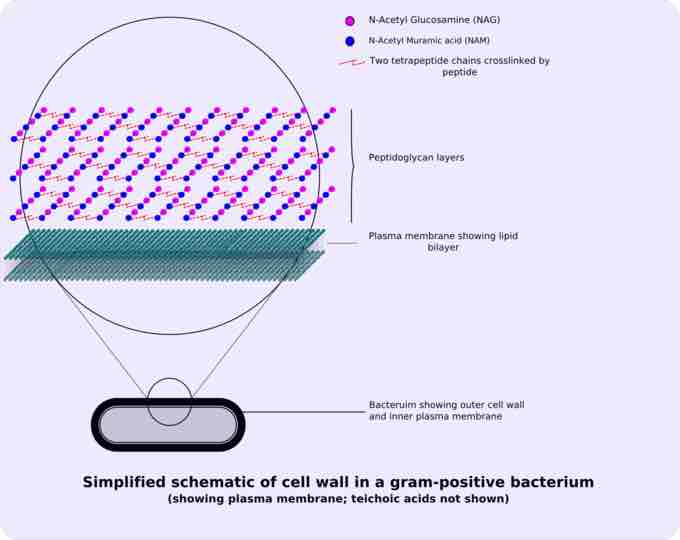Peptidoglycan, also known as murein, is a polymer consisting of sugars and amino acids that forms a mesh-like layer outside the plasma membrane of bacteria (but not Archaea; []), forming the cell wall. The sugar component consists of alternating residues of β-(1,4) linked N-acetylglucosamine and N-acetylmuramic acid. Attached to the N-acetylmuramic acid is a peptide chain of three to five amino acids. The peptide chain can be cross-linked to the peptide chain of another strand forming the 3D mesh-like layer. Some Archaea have a similar layer of pseudopeptidoglycan or pseudomurein, where the sugar residues are β-(1,3) linked N-acetylglucosamine and N-acetyltalosaminuronic acid. That is why the cell wall of Archaea is insensitive to lysozymes, which are present in human sweat and tears as part of innate immunity.

Simplified sc hematic of a cell wall in a Gram-positive bacteria
Cross-linking between amino acids in different linear amino sugar chains occurs with the help of the enzyme transpeptidase and results in a 3-dimensional structure that is strong and rigid.

Peptidoglycan structure
The peptidoglycan layer in the bacterial cell wall is a crystal lattice structure formed from linear chains of two alternating amino sugars, namely N-acetylglucosamine (GlcNAc or NAG) and N-acetylmuramic acid (MurNAc or NAM).
Peptidoglycan serves a structural role in the bacterial cell wall giving it strength, as well as counteracting the osmotic pressure of the cytoplasm. A common misconception is that peptidoglycan gives the cell its shape. However, it is actually the MreB protein that facilitates cell shape. Peptidoglycan is also involved in binary fission during bacterial cell reproduction.
The peptidoglycan layer is substantially thicker in Gram-positive bacteria (20 to 80 nanometers) than in Gram-negative bacteria (7 to 8 nanometers), with the attachment of the S-layer. Peptidoglycan forms around 90% of the dry weight of Gram-positive bacteria but only 10% of Gram-negative strains. Thus, presence of high levels of peptidoglycan is the primary determinant of the characterisation of bacteria as gram-positive. In Gram-positive strains, it is important in attachment roles and stereotyping purposes. For both Gram-positive and Gram-negative bacteria, particles of approximately 2 nm can pass through the peptidoglycan. Gram-positive and Gram-negative bacteria are sensitive to different types of antiobiotics.